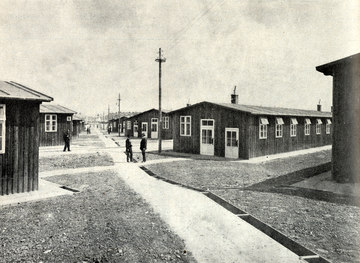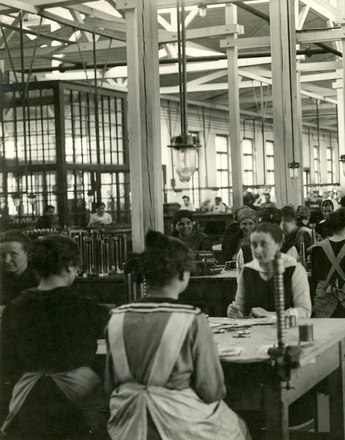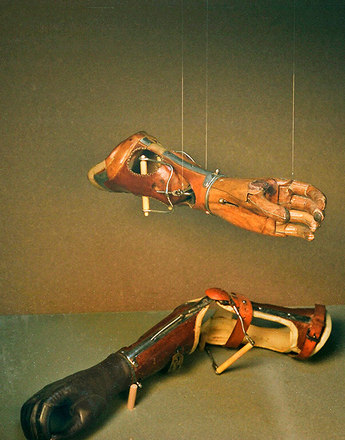The great demand for beds made it necessary to set up a number of emergency or barrack hospitals. In spite of their name and makeshift character, they were modern and functional and designed to handle the constant flow of soldiers arriving from the front.
The deficient hospital infrastructure and the fear of infectious diseases soon made it necessary to create additional capacities by constructing new buildings and annexes or converting existing ones. “Emergency barrack hospitals” were built from autumn 1914 on the outskirts of Vienna originally to isolate infectious diseases, particularly soldiers suffering from dysentery. They were constructed according to a scientific industrial management system called Taylorism. It followed strict functional criteria and could have as many as sixty or more barrack rooms. The hospitals were commissioned by the city of Vienna and the Ministry of War.
The first war hospital of this type was built at the edge of Wilhelminenspital, the second on Triester Strasse south of the Kaiser-Franz-Josef-Spital. Other war hospitals were built in Baumgarten, Meidling, the Arsenal, Simmering at the present-day housing estates at Hasenleiten 7 and 8, and finally between Grinzinger Allee and Daringergasse next to Ober-Döbling station on the suburban railway line. Most of the barracks were demolished between the wars.
The buildings commissioned by the city of Vienna alone in 1914 cost 1.2 million krone. These relatively high costs are explained by the need to install supply and disposal systems as well as washing and disinfection facilities. The plans of the time indicate that they also had extensive and well equipped underground constructions.
War Hospital No. III was built in 1914–15 in Baumgarten next to the present-day Oberbaumgarten parish church. A photo album compiled by the prominent “photographer of architecture, art and industry” Martin Gerlach shows a railway siding, administration building, well ventilated barracks, operating theatres, a pharmacy, kitchen, physiotherapy rooms and a church.
The importance of rail connections for the emergency hospitals is illustrated by the case of the barrack hospital in Arsenalstrasse in the 10th district. A technical description of a second side line from the Ostbahnhof to the Arsenal and the municipal hospital barracks makes special mention of the fire safety in view of the nearby armoury.
The largest emergency hospital, War Hospital No. VI, had 4,500 beds and many more patients than that. On the basis of the Ministry of War decree of 16 November 1914 concerning the construction of barrack hospitals, the land belonging to St. Laurenz parish in Simmering-Hasenleiten between Bahndamm, Hasenleitengasse and Wiener-Neustädterkanal was requisitioned and the hospital built in 1915. Some of the fifty wooden barracks were constructed by Bulgarian soldiers stationed there. It had transformers to supply electricity, a nursery garden, pigsty, workshop and coal depot and was thus extensively self-sufficient. Up to 1,000 patients were admitted on some days. The hospital also had an attached physiotherapy institute with some Swedish personnel, an indication of the importance of external injuries at the expense of combating infectious diseases, for which the (disinfection) barracks had been originally designed. Other emergency hospitals had similar facilities.
Translation: Nick Somers
Biwald, Brigitte: Krieg und Gesundheitswesen, in: Pfoser, Alfred/Weigl, Andreas (Hrsg.): Im Epizentrum des Zusammenbruchs. Wien im Ersten Weltkrieg, Wien 2013, 294–301
Goldemund, Heinrich: Kriegs-Notspitäler der Stadt Wien, Wien 1915 (SD aus Zeitschrift des Österreichischen Ingenieur- und Architekten-Vereines 1915, Heft 13-16), 1–30
Weinmüller, Renate: 75 Jahre Hasenleiten. Vom k. u. k. Kriegsspital zur Wohnsiedlung, in: Simmeringer Museumsblätter 35 (1990), 240f
-
Chapters
- Modern weaponry and the slaughter of the first months of the war
- Hospital capacities, epidemic service and the rapid shortage of skilled medical staff
- Emergency hospitals in Vienna
- The university and other temporary hospitals
- Künstlerhaus and Secession as temporary war hospitals
- Wounded transports, food and care
- Cured and well-fed for the war





